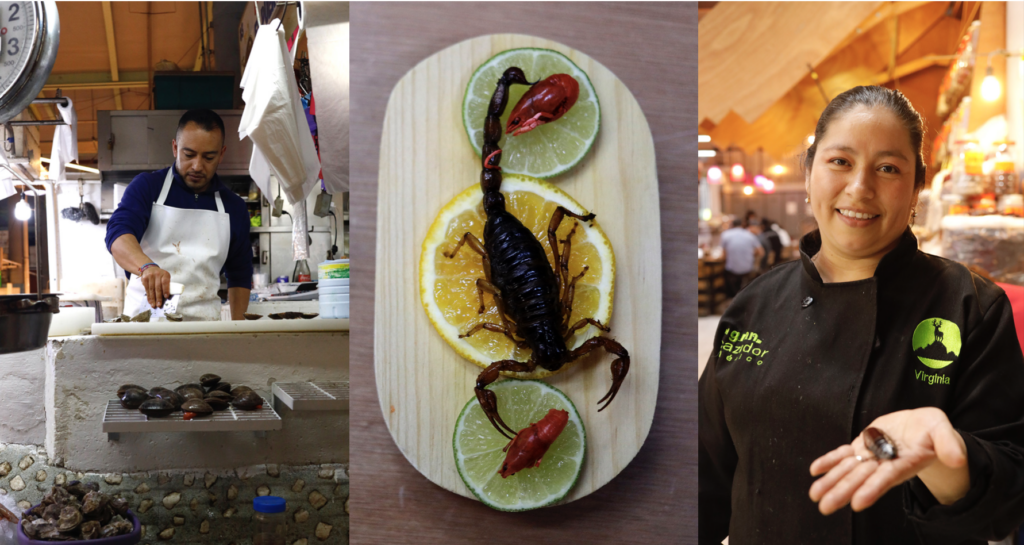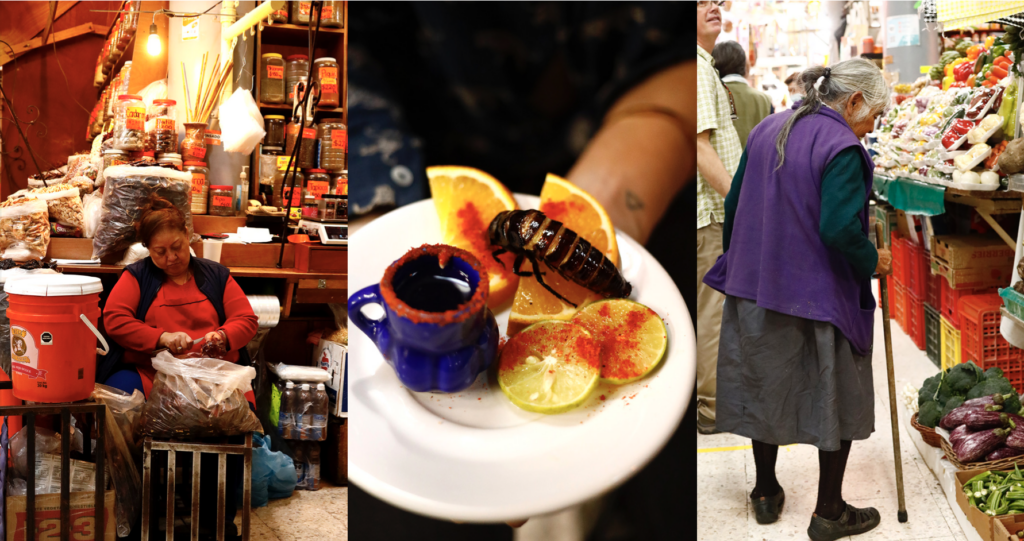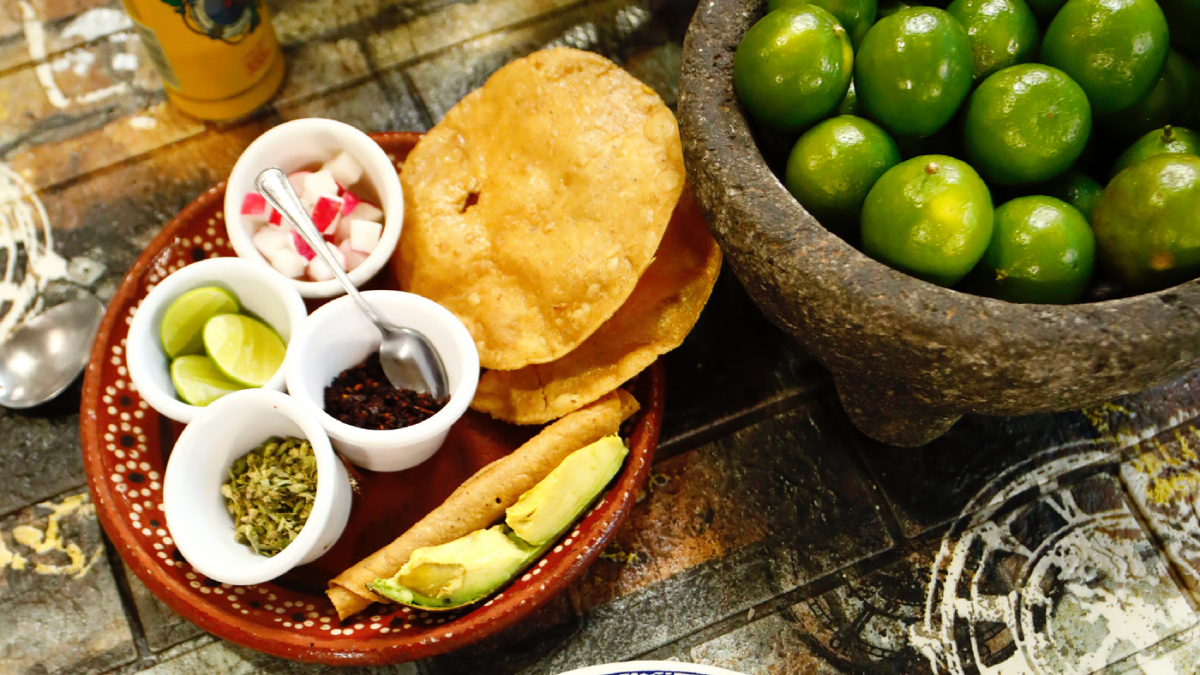Click here to read the Spanish version.
Visitors walk through the aisles of the market accompanied by the lively atmosphere that the music invites. The band -leather jackets, black hats and red bandanas around their necks- plays huapango, a genre from the Huasteca Potosina region. Enlivened by the chords of the jarana and the violins, the crowd wanders at a slow pace from stall to stall, their eyes amused by the extensive gastronomic offerings. The variety of international food offered by the San Juan market, located in the central heart of Mexico City, and one of the most emblematic, becomes dizzying.
The Spanish offer is one of the most generous: black pudding from Burgos, Catalan sausages, chorizo from Salamanca, very green olive oil from Jaén; cured and aged cheeses from La Mancha, the Basque Country and Asturias. A splendid variety of handmade sausages that vendors display on trays to honor homelands from across the ocean and from practically all over the world: the most varied seaweed and vegetables from China, the most colorful tubers from the Caribbean.
Hay tres elementos inmutables a los que este mercado es fiel: variedad, calidad y originalidad, que lo posicionan como una de las principales atracciones turísticas de la capital. Este histórico lugar de mercaderes recibe más de dos mil visitantes a la semana, rostros con rasgos de todas las nacionalidades que cruzan los estrechos pasillos donde se amalgaman los gritos de los vendedores locales y las lenguas extranjeras.
“The people who visit us the most are mainly gringos, but also many Europeans and Asians,” says Doña Amalia while she cleans vegetables. Much of Mexico’s gastronomy is shaped by its landscapes: the banana and mango trees of the tropics, the cornfields on the slopes of the volcanoes, its imposing deserts where the nopal cactus, the country’s emblematic cactus, sprouts. “It is eaten raw or roasted, in tacos, in salads like lettuce, stuffed with cheese, stewed in eggs and with guajillo”, explains the shopkeeper.
AT “EL GRAN CAZADOR”, MEAT FROM LLAMA, ZEBRA, OSTRICH, LION, ANTELOPE, BUFFALO OR CROCODILE IS SOLD.
Chicatana ants are seasoned with this bright reddish dried chile in the stand next to Doña Amalia’s fruit shop. “But we put little spice because we get a lot of foreigners who can’t stand it,” says Vicky Rosas. She has been dedicated to gourmet cooking for more than a decade and her specialties are insects and exotic meat. El Gran Cazador, a family business with more than 40 years of experience, distributes its butcher’s products in some of the city’s top class establishments, such as the Puyol and Quintonil restaurants. It also functions as a small dining room. Its menu, one of the most original in the market, offers ostrich, antelope, llama, buffalo and zebra cuts. “The favorites are always crocodile and lion, which comes from certified farms,” says the cook, as she pulls out a sample board with six different meats. “Don’t you want to try it?” she asks with a smile to a group of tourists passing by the stall. “Its flavor is strong, the meat is tough and chewy, because it is very muscular. The lion’s is the most different from all the others, one of my favorites! In front of her, two friends savor a crocodile mixiote. They say the reptile delicacy tastes fishy, “but for the palate to define a flavor you have to taste it,” insists Rosas, wiggling a huge Madagascar cockroach in the pan, “They are fed with oranges and apples, so they acquire a sweet taste that mixes with the salty. If they get rid of the prejudice they’ll really enjoy it.”

In front of her small kitchen, open to the public, foreigners crowd to observe the jars of sauces made from grasshoppers, the samples of maguey worm salts, the succulent plant from which tequila and so many other Mexican liquors are made. “They are for tasting our mezcal,” announces the cook, pointing to the table of insects in front of the bottles: seasoned and dismembered grasshoppers in a stone mortar, chopped flying beetles, baked parakeets, “which are the pest of the avocado tree and taste very tasty,” says Rosas.
Among all these snacks with roots in pre-Hispanic cultures, visitors can also find escamoles, ant roe, considered the Mexican caviar, or fried scorpions dipped in chocolate. “The toasted tarantulas taste like chicken with a slight shrimp flavor. The little hairs put my tongue to sleep,” says a Chilean woman. Next to her, a Colombian couple is encouraged by the toasted spider mites: “they taste like popcorn”.
Among the countless products for sale are seasoned grasshoppers, chopped flying beetles, baked parakeets, escamoles, ant roe (Mexican caviar) or fried scorpions dipped in chocolate.
According to the cook at El Gran Cazador, “people are increasingly encouraged to try exotic food”. However, most of the visitors to this market come in search of the best fish and seafood. The seafood products offered here ensure the fairest prices, with rows and rows of exhibitors where fresh oysters, crab claws or chocolate clams, products that come from the farthest coasts of the country, such as Baja California Sur, are displayed among ice cubes.
“In this market they serve the best ceviche,” says Guadalupe. She is 78 years old and a frequent customer. “Today, since it is Thursday, the day of pozole acapulqueño, I came to try it”. This broth, from the tropical southern region, “is prepared with dried cacahuazintle corn and part of the pig’s head, and is seasoned with lemon juice, salt, hot sauce or ground piquin chili, lettuce, sliced radishes, chopped onion and ground oregano”, explains Victor, the owner of the restaurant.

He arrived in the city more than a decade ago from Acapulco and opened his business in the market, so far from the sea he misses and from his origins. “But here we try to replicate the more traditional cuisine of my coast,” assures the southerner before serving two plates of ceviche to a couple from Japan. They have been in Mexico City for four days and they were recommended different markets. This is the fourth they have visited and their favorite, “because of the colors and the diverse people who pass through it,” they say. But, above all, for inviting them to a unique gastronomy, a mixture of countries and cultures past and present, between the exotic and the everyday, so many borders that fade away in the lively aisles of the San Juan market.
Photos: Javier Cortés.

